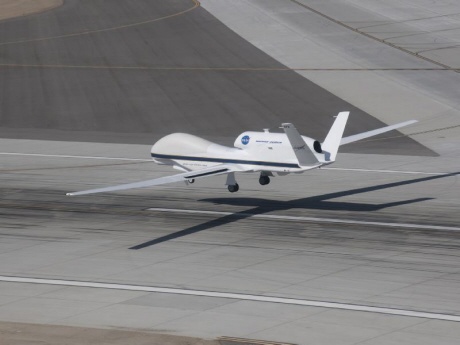From GloPac co-mission scientist Paul Newman:
It was a tense moment on Friday morning, April 2. The Global Hawk was poised on the end of the runway, with the crew chief behind it in a pick-up truck (“the trapper” is the runway-based eyes and ears for the crew in the control room). Pilots, managers, and scientists sat in the darkened Global Hawk Operations Center (GHOC), intently staring at their computer screens and the LCD monitors.
At 6:56 AM Pacific, the pilots commanded the takeoff from their computer and we watched the Global Hawk begin to accelerate down the runway. We listened over our head-sets as the trapper followed the jet and called out it’s speed. We watched the screen as the plane gently lifted off the runway and soared towards the stratosphere. As the Global Hawk lifted off, the scientists in the GHOC’s payload operations room broke into applause.
Why did we applaud? Two reasons. First, everyone was happy that we were flying after three weeks of hard work installing our instruments and solving a myriad of hardware and software problems.
Second, and more importantly, it was applause for the engineers, managers, and crew of the Global Hawk. Chris Naftel and his Dryden team have made the Global Hawk a reality for science.

This was an historic occasion — the first test flight of the Global Hawk carrying a science payload. This flight ushers in a new era that combines state-of-the-art aircraft hardware and science instruments with software — a hybrid of satellites and aircraft for future science. I imagine that in the future there will be fleets of these aircraft probing our atmosphere and providing information for weather forecasting, hurricane reconnaissance, ozone depletion, and climate change.




Congrats to Global Hawk team, as the robo-plane is in the air over the Pacific for the first time today. Good luck!
What an incredible accomplishment. I had the opportunity to visit with some of the project leads yesterday (thanks Paul, Dave and Chris) while Global Hawk was in flight and was very impressed how the entire team was working together. What a fantastic start to this mission!
I guess i’m missing why this is a huge deal. they strapped a weather station to ten-year-old predator technology. isn’t this simply a glorified weather balloon? is this all that Nasa is left with after the budget cuts and redefinition of its mission? I’m also not that thrilled at the idea of having “fleets of these aircraft” in our skies in the future, seems like a lot of wasted fuel for what we could get from a helium platform.
I like this idea, I mean to reuse military technologies for science. It’s not new of course. A drone can be more flexible then a balloon – you can steer it.
I don’t know why the balloon in Australia was smashing the car, but a drone you should be able to be landed/run a landing program. By the way, I don’t think that this accident was related to the decision to use drones.
I think NASA won’t throw away any balloon. For it’s specific duty they are great. But, both are tools! If you want to put a nail in the wall, you will not use a drill for it. If you want to screw something together — don’t use a hammer for the job!
Applause well merited It was applause for the engineers, managers, and crew of the Global Hawk. Chris Naftel and his Dryden team have made the Global Hawk a reality for science. This was indeed an historic occasion. Congrats to Global Hawk team and good luck…
NASA is not the only agency or organization using UAV platforms for atmospheric/oceanographic research. The National Oceanographic and Atmospheric Administration [NOAA] is starting to look at using or is using UAV platforms.
http://uas.noaa.gov/
The ongoing VORTEX2 experiment in the plains states is another example.
http://www.vortex2.org/home/
The UAV, as noted before, can cover large geographic areas at different altitudes, with long duration while still carrying a large package of scientific instrumentation.
FWIW I am a former Senior Electronics Technician (now retired) with the NOAA Office of Aircraft Operations and flew as an aircrew member on their WP-3D research aircraft. In our case we were limited to flight durations of about 10 hours and what altitudes were safe particularly during hurricane research and reconnaissance flights.
Personally I applaud this use of new technology. Great job folks. I just wish I was there…
Chris Naftel is a genius and I’m glad to see this administration finally pumping money into NASA and science. It’s been far too long we need to move ahead and with people like Chris and money we can accomplish allot